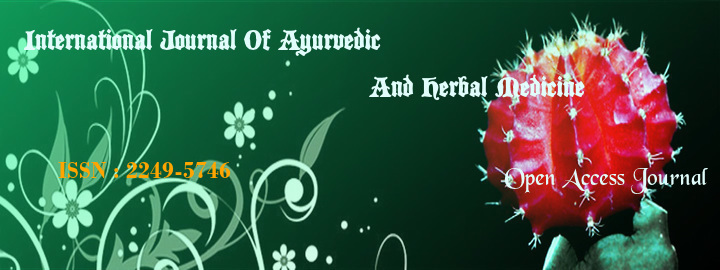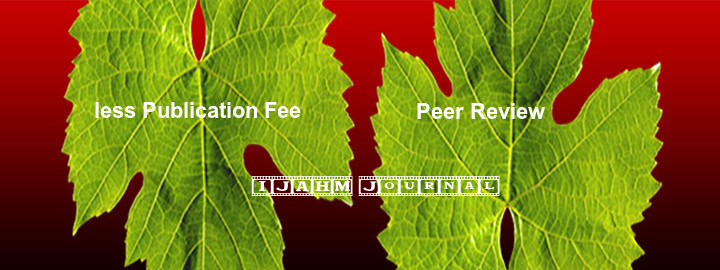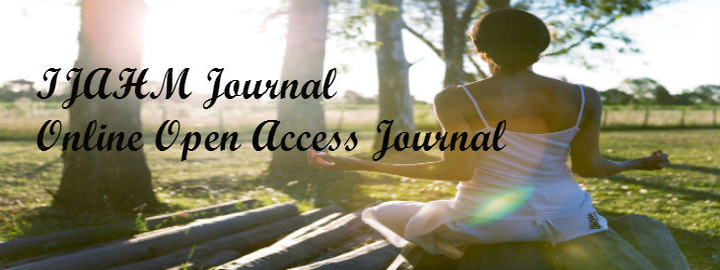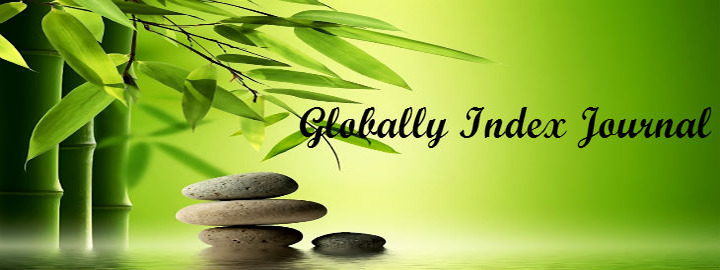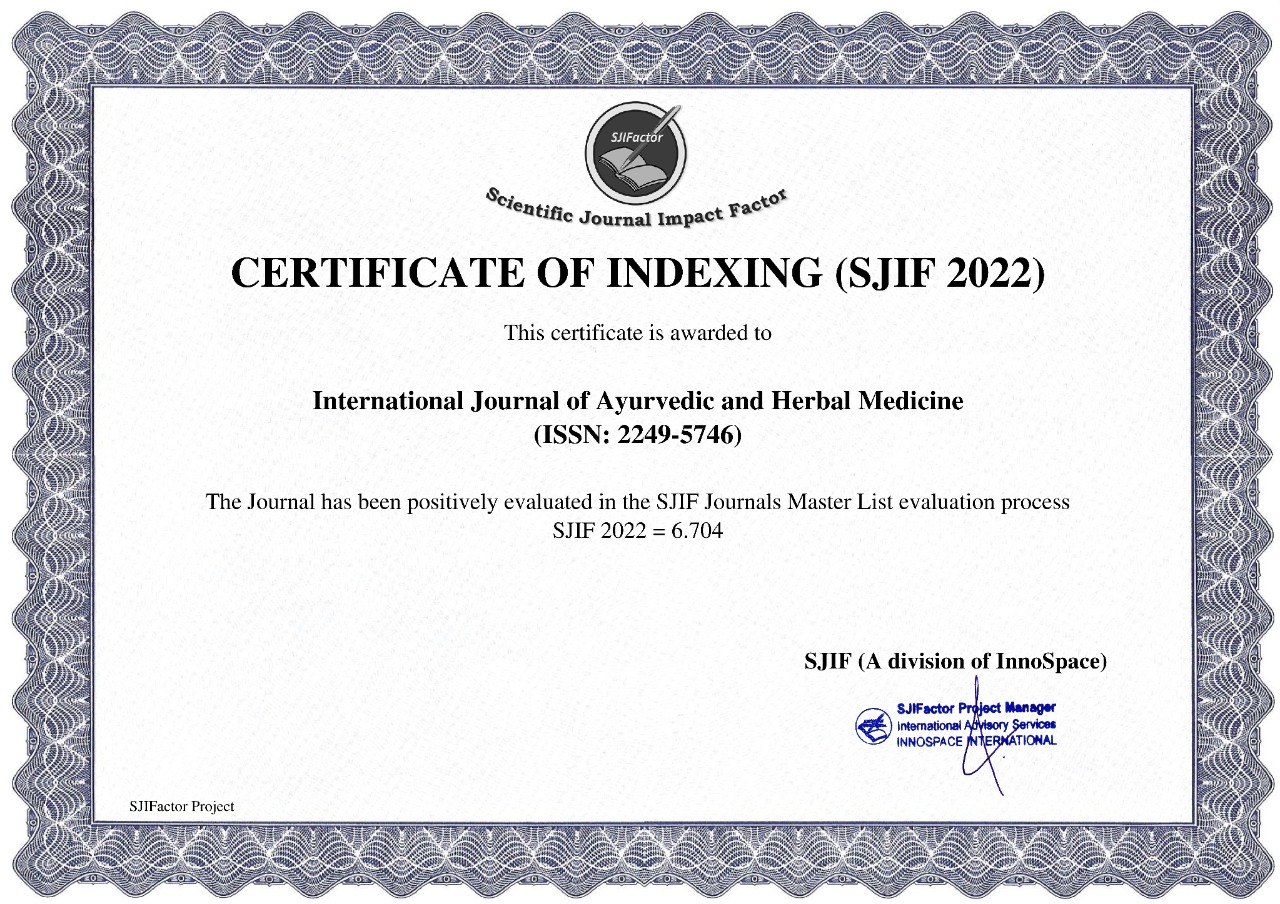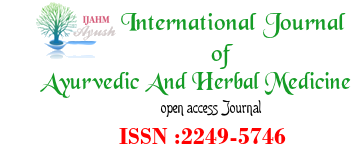


Title : An Ayurveda Approach for the Management of Fibromyalgia(A Literary Review)
Authors : Sharma Chakrapany * Singh Chandan ** Purvia Rajendra***
Abstract : Fibromyalgia is estimated to affect 2–4% of the population, with a female to male incidence ratio of approximately 9:1. Three percent ( 3% ) of the Indian population suffers from fibromyalgia, only 0.5% are aware of the conditions and the number of doctors who specialize in this in India are less than the numbers one can count on fingers”. Fibromyalgia is an anomaly. It is a condition still not fully understood and in some instances not accepted by mainstream medicine, although The American College of Rheumatology recognizes and defines it as a disease. Fibromyalgia is frequently co-morbid with psychiatric conditions such as depression and anxiety and stress-related disorders such as posttraumatic stress disorder. Fibromyalgia, a central nervous system disorder, is described as a "central sensitization syndrome" caused by neurobiological abnormalities which act to produce physiological pain and cognitive impairments as well as neuro-psychological symptomatology. Certain antidepressants such as amitriptyline and duloxetine have been found to be effective treatments as has the anticonvulsant drug pregabalin. Exercise improves fitness and sleep and may reduce pain and fatigue in some people with fibromyalgia. There is no permanent cure for FM; therefore, adequate symptom control should be goal of treatment. This paper / article reveals the some studies have been performed evaluating the role of herbs or herbal medicine for efficacy on fibromyalgia (FM). Massage therapy have the best evidence for effectiveness with FM. Massage is one of the oldest healing therapy. The massage is a part-n-parcel of the Panchakarma therapy in Ayurveda, which is gaining popularity for the rejuvenation purpose and for the treatment of arthritic disorders, neurological disorders and life style disorders. Using the basic principles and remedies from Ayurveda, may find out the solution for this syndrome. Herbals have a higher rank for the treatment of FMS. Many FMS patients seek relief from herbal remedies for symptomatic problems. Ayurveda approach is well and good, but ultimate relief should be found in combinations of herbals along with other adjunctive recommendations. Panchakarma, Massage therapy, Marma therapy of Ayurveda also can play a vital role in this concern. Present paper is an attempt with in-depth literary review to explore the possible use of Ayurveda for the management of the Fibromyalgia.
Title :To Study The Efficacy Of Virechana By Aragvadha Kwatha In Pittaja Kushtha
Authors : Dr. Chaudhari M. V.
Abstract : Subjects suffering from Pittaja Kushtha (Skin diseases having symptoms- redness, pimples, discharge, burning sensation, itching) aged between 30-60 years, irrespective of sex, cast, religion, socioeconomic strata was studied. For each subject the study terminated after a maximum period of 21 days from enrollment and included regular visits to Hospital for Poorvakarma (Internal & external Snehana, Swedana), Pradhan Karma (Virechana) & 1 follow up visit after 7 days of Virechana. After consenting to participate subjects were put on 15 days wash-out period for Allopathic medicine & 7 days for Ayurveda medicines; & before being administered the investigational product. On baseline visit (Day 1), medical history and physical examination were performed, an Inclusion criterion was assessed and the trial treatment, i.e. Virechana by Aragvadha Kwatha was explained & subject started for Poorva-Karma (Internal & external Snehana, Swedana). After optimum signs of Internal & external Snehana, Swedana achieved then on next day morning about 8 A.M. empty stomach Aragvadha Kwatha (prepared as described in SOP) was administered orally & subject was observed through out the Pradhan Karma for Ayoga, Samyaka Yoga, Atiyoga or Vyapada. After completing of Pradhan Karma subject was advised for post Panchakarma behavior regimen & Samsarjana Krama (diet regimen). On Day 21, subject was again accessed for the same symptoms. Safety was assessed primarily through incidence of adverse events (AE) & clinical evaluation of the subject. Observations: It is observed that in the study treatment, i.e. Virechana by Aragvadha Kwatha in Pittaja Kushta; P-value <0.05, hence considered as significant. Discussion: Comparative data analysis revealed that the ‘p’ value in all the symptoms (redness, pimples, discharge, burning sensation & itching) was highly significant. From the data of the objective features, the ‘p’ values were almost highly significant (P < 0.001) in all the parameters. Hence, it can be concluded that the Virechana by Aragvadhadi Kwatha is more effective in Pittaja Kushtha. The results are encouraging and support the classical claim that Aragvadha is effective in reducing the symptoms of Pittaja Kushtha and can be used extensively in the treatment. Probable mode of action of the Aragvadha in Pittaja Kushtha: All types of Kushtha are Tridoshaja, hence one should treat the patient according to dominance of vitiated Dosha. Symptomatically the vitiated Dodha which is more dominant that should be treated first (Ch. Chi. 7/29, 30). As per these guidelines of Charak, instead of going in details of 18 types of skin disease, this study is about Pittaja Kushtha. Charaka has recommended Shodhana in Pittaja Kushtha & has given more emphasis on Virechana Karma to balance the vitiated Pitta Dosha. Much number of drugs is described for Virechana Karma in classical texts. Out of these, for the present study Aragvadha (Cassia fistula Linn) was selected. Charaka has considered it as the best Virechana Dravya. Aragvadha is Madhura, Tikta Rasa; Guru, Mridu, Snigdha Guna; Sheeta Virya and Madhura Vipaka. Hence, the drug is useful in Pitta vitiation. In Ashtanga Hridaya, Aragvadha is described in the Kaphaghna Gana and in Sushruta Samhita, Aragvadha has been described as the Adhobhagadosahara Dravya. As per Charaka Samhita, Aragvadha is the best Mriduvirecana drug. Therefore, it helps in Kapha Nirharana along with Vatanulomana. Thus, the drug helps in Dosha-Dushya Vighatana in the disease Pittja Kushtha. Conclusion: Aacharya Charak has explained very precisely about Shodhana & Shamana treatments of Kushtha with the formulations useful for it. He had given more emphasis on examining the Dosha Pradhanata instead of going details with types of Kushtha which is practical approach. Though it has been observed that Sushruta has described contamination is one of the Hetu (reasons) for Kushtha. About types some differences are finding in their categorization as Mahakushtha & Kshudrakushtha in between Charak & other Samhitas. According to dominance of vitiated Dosha, types are explained by Charak & as well as they are mentioned precisely in Madhav Nidan also. The quotation given by Vagbhata & Chakradatta is to be considered while treating skin diseases which advise to do Virechana every month in this disease. On the basis of the results of this study it may be concluded that, analysis of the data of the present study reveals significant Kusthaghna activity of Aragvadha in subjects with Pittaja Kushtha (skin problems due to vitiated Pitta Dosha). As there was no complication, we can conclude that Aragvadha is safe drug of choice for Virechana in Pittaja Kushtha.
Title : Stress Relaxation Through Ayurveda
Authors : Dr. Balaji Deekshitulu P.V,
Abstract : The review of the study ayurveda in general, is used to mean a healthy balance of the mind and body in an overall feeling of well being to describing the existence of positive health of stress in an individual as exemplified by quality of life, Ayurveda, meditation, yoga, physical exercises and a balanced diet. It is like rejuvenation and clean up process on all levels physical, mental and emotional. Ayurveda systems of medicine are over 5000 years old. The concept of Stress Problems of mind and these determine Ayurveda is guided best treatment. Ayurveda is highlighted as a holistic system with its concern for prevention and promotion of stress and mental health.
Title : Significant Role Of Dashmool Taila Matra Basti In The Management of Pravahika
Authors : Dr.Neeraj Khare1*, Dr.Surendra Patel1**, Dr.Anurag Pandey2, Dr.Mahendra Singh3
Abstract : In today’s modern and busy scheduled life people have a less time to pay attention to their diet and eating habbits. They use to take unhygienic, vitiated food. Taking a fast food, junk food & Chinese food is a fashion nowadays. Hurry, worry and curry causes intestinal upsets frequently and that leads to gastrointestinal problems. Pravahika is also one of the important and oftenly occurring vyadhis of Annavaha and Pureeshvaha Srotasas in current time. Its main cause is Agnimandya.
Authors : Weerasekera KR1*, Weerasekera S2
Abstract : Pīnasa is a most common disease and can be seen in every age category in the Sri Lankan society. Pīnasais the term used inDeshīyaChikitsa (traditional medicine) found to be similar to Apīnasa in Ayurvedic medicine and Allergic Rhinitis on the basis of symptoms of modern medicine.Most of the people suffer physically and mentally from this disease. But till now there are no any specific treatments found in other medical fields for Pīnasa.For this present study, one of the stubborn diseasesPīnasahas been selected, which is well known for its recurrence and chronicity. Recurrence occurs when theDoshāsare not evacuated from the body completely and suchDoshāsin their latent stage give rise to the same disease, whenever the etiological factors are favorable. This study is preliminary based on to search literature about the Pīnasroga and basic treatments described in Sri Lankan Traditional Medicine. The number of types of Pīnas are variable and there are 15, 18 and 19 according to this study and Hisagallum(applypaste on head),Dhūma(smoking), and Karnapūrna(ear drop) are the special treatment methods use in traditional medicine. Apart from these methods,Kashāya(decoctions), Chūrna(powders), Guli(tablets), Kenda(kanji), Ālepa(paste), Nasya(snuffing) and Anjana(Collyrium) are mentioned. Traditional physicians use many traditional oils for the treatment and among the decoctions Vajrakānthikashāyaknown as the best decoction for the Pīnasroga. Use of classical yoga exercises and prohibited of use warm water is the specially indicated for the Pīnasroga in traditional medicine in Sri Lanka.
title : Genetic factor of Depression-concept of Ayurvedic management
Authors : Rinki, Aruna Agrawal, G.P.Dubey
Abstract : Globally, depression one of the neurological disorder has been described as millennia linked with neurobiology associated to direct neurochemicals and biochemical incredible factors interact with gene –environment and as long as a scaffold for future better explore. For the details knowledge of the disease depression we can consult with traditional Indian medicinal system i.e. Ayurveda. According to Ayurveda the term Depression is co related with Vishada (Depression=Vishada). In the manner of conceptual and etymological study of depression Ayurveda has firstly described Depression as a Vishada. Ayurvedic Acharyas (righter) described depression as a Vishada in many places as a disease, symptoms and etiological factor of many psychological as well as physical diseases. In this review article we have outline the upshot of altered regulation of particular neurochemicals, molecular biology, genetics with significant role of ayurveda have great evidence to study the mechanisms, plasticity and neuronal survival involved in depression and biggest impact of Indian classical therapy in the management of depression
[thead]
[tab class="active" type="tab" href="#dws_first_tab92" title="Citation"]
[tab class="" type="tab" href="#dws_tab137862606824692" title="Abstract"]
[tab class="" type="tab" href="#dws_tab137862608993992" title="Download PDF"]
[/thead][tcontents]
[tcontent class="active" id="dws_first_tab92"]Title : Herbs in Inflammation - A Review
Authors : P.L.Rajagopala*, K.K.Dhilnaa , P.N.Sajith Kumarb, Jeril Johnc[/tcontent]
[tcontent class="" id="dws_tab137862606824692"]inflammation is a “surface” phenomenon triggered by immunological and non-immunological stimuli, capable of activating both humoral and cellular systems, normally present in the body in an inactive state and regulated by systemic inhibitors.[/tcontent]
[tcontent class="" id="dws_tab137862608993992"]Click Here Download PDF[/tcontent]
[/tcontents]
[/tabs]
index







